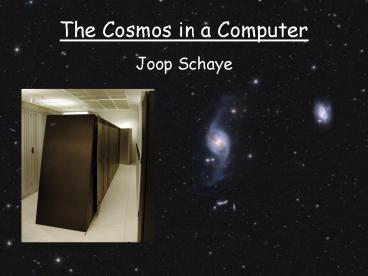The Cosmos in a Computer - PowerPoint PPT Presentation
1 / 23
Title:
The Cosmos in a Computer
Description:
shock-heated baryons. Cold Dark Matter, baryons. Primordial fluctuations. Gravity. Hubble Expansion ... Simulation videos. Simulation of growth of structure ... – PowerPoint PPT presentation
Number of Views:53
Avg rating:3.0/5.0
Title: The Cosmos in a Computer
1
The Cosmos in a Computer
- Joop Schaye
2
History of the Universe
3
The Composition of the Universe
4
The Composition of the Universe
5
Length Scales (cm)
6
Galaxy Formation
Cold Dark Matter, baryons Primordial fluctuations
Hubble Expansion Pressure
Gravity
Dark matter halos shock-heated baryons
7
Galaxy Formation
Dark matter halos, shock-heated gas
8
(No Transcript)
9
(No Transcript)
10
z14 t0.3
z5 t1.2
z1.4 t4.7
z0 t13.8
11
Density evolution
12
Why do we need simulations?
- Astrophysical phenomena are generally
- too complex solve analytically
- too extreme to replicate in the lab
- Simulations allow one to
- Gain physical insight through controlled
experiments - Test theories
- Measure model parameters
- Create virtual observations, used to
- Test data analysis methods
- Reveal selection biases
- Design instruments/telescopes
13
Ingredients
- Coordinates comoving
- Hubble expansion solved analytically and scaled
out - Cubic, cartesian for cosmological simulations
- Only place where General Relativity plays a role
- Boundary conditions
- Periodic for cosmological simulations
14
Ingredients
- Initial conditions
- Seed fluctuations from inflation
- Gaussian distribution
- Scale-dependent
- Linear evolution solved analytically, start at
redshift z50-1000 - Components
- Cold dark matter gravity
- Gas gravity hydrodynamics, source/sink of
radiation - Stars (form during simulation) gravity, source
of radiation, chemical elements - Radiation radiative transfer
15
Ingredients
- Minimum and maximum length scales
- Much greater than scale of interest
- Resolution set by computational limitations
- (Semi-)analytic models of unresolved, (subgrid)
physics - Emission/absorption of radiation (cooling)
- Star formation
- Stellar mass loss (winds/supernovae)
- Black holes
16
Ingredients
- Discretization
- Mass (Lagrangian) particles or
- Length (Eulerian) cells
- Time step such that changes are small (time step
ltlt spatial resolution / velocity) - Adaptivity
- Spatial
- Built-in for particles (N-body, SPH)
- Grids within grids (AMR)
- Mass Varying particle masses
- Time Individual time steps
17
Computational demands
- Memory scales with number of resolution elements
- 10243 floats 4 GBytes
- 3 positions, 3 velocities, mass, density,
temperature, chemical composition, - CPU time scales with number of time steps, which
scales with spatial resolution - Parellelization
- Multiple CPUs compute simultaneously
- Distributed memory CPUs only fast access to
local memory only
18
A slice of the z0 universe
19
Simulation videos
- Simulation of growth of structure
- Evolution of a cluster of galaxies
- Formation of an elliptical galaxy
- Formation of a spiral galaxy
- Dwarf galaxy with feedback
20
Simulation videos
- Simulation of growth of structure
- Evolution of a cluster of galaxies
- Formation of an elliptical galaxy
- Formation of a spiral galaxy
- Dwarf galaxy with feedback
21
OWLSOverWhelmingly Large Simulations
30 M CPU hours awarded
22
Main Questions
- Where is the ordinary matter and how can it be
detected? - What role does environment play in the formation
and evolution of galaxies? - Where are the heavy elements and how were they
dispersed from the stars in which they were
created?
23
Help
- Claudio Dalla Vecchia Oort 434
- Marcel Haas Oort 436































